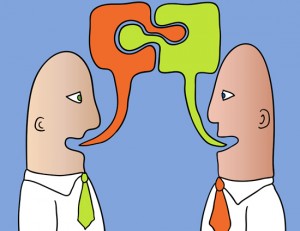 I’ve been researching and thinking about the psychology of the social web and our Internet relationships. There are many common psychological techniques you can use in your every day Internet marketing. Here are a few ideas to â€psych†your visitors into spending more time on your website and your blog.
I’ve been researching and thinking about the psychology of the social web and our Internet relationships. There are many common psychological techniques you can use in your every day Internet marketing. Here are a few ideas to â€psych†your visitors into spending more time on your website and your blog.
1) Social proof is king
In real life, “social proof†is the trappings of society that impart influence.  A person’s height, a fancy car, a diploma … all help determine influence, subconsciously. Since we don’t have those physical clues in the online world, we look to “badges†like Twitter followers and Klout scores to provide a shortcut assessment.
With the density of information in today’s world, these badges are more important than ever.  In fact they may be even more important than your real knowledge, experience and accomplishments.  Strange but true. Think about your favorite blogger. I’ll bet you notice some of their badges like followers, AdAge rank, or tweets on a blog post, before you investigate their education or level of professional experience.
We make the same assessments about websites and blogs. If you see a lot of tweets and comments, testimonies and awards, you assume something good is going on there.
Another way to accomplish this on a website is product reviews and ratings. Make sure ratings and reviews are clearly displayed on your site or product pages. Allow users to include information about themselves such as their gender, name, location and occupation. This makes the reviews even more compelling since it can create a connection to the demographics of your site visitors.
2) Give web tourists a reason to become residents
 In the first few seconds you have a visitor on your site, are you giving them a reason to stay a little longer to learn about you? This is commonly called a “call to action.†On my website, you can click to see free materials, download an eBook, watch videos, read case studies, listen to a podcast, read my blog … basically I give people lots of reasons to hang around by providing valuable material that would interest my target customer.
In the first few seconds you have a visitor on your site, are you giving them a reason to stay a little longer to learn about you? This is commonly called a “call to action.†On my website, you can click to see free materials, download an eBook, watch videos, read case studies, listen to a podcast, read my blog … basically I give people lots of reasons to hang around by providing valuable material that would interest my target customer.
On my blog one of the most effective devices I have to help people stick around is the “Linked Within†app at the bottom of each post suggesting further reading.  This dramatically increases time on the site and increases page views on my blog by about 8 percent.
3) Put the most important action at the top
When you’re plotting out your call to actions, put your most important one first. The idea behind this is simple: what comes first is unconsciously regarded as the best. I’ve been experimenting with this myself. One other consideration — if you’re stacking your calls to action down the right side of your page, keep in mind that the top right corner of your website is a blind spot. This is spooky but it really is true.
One time I was offering a free download at the upper right corner of my site. I was in a meeting with a web designer and was talking about the problem in front of a huge display screen of my website. I said “Without looking at the screen, can you tell me if I have a free download offer on my landing page?†Although we had been looking at the page all morning, he completely missed this element. So, highlight your best offers first, but watch where you place them!
4) Provide instant gratification
 When deciding to make a purchase, we are often influenced by how fast we can have the product. Reduce or eliminate fields required to purchase or engage. The other day I was required to register to comment on a blog. FAIL!
When deciding to make a purchase, we are often influenced by how fast we can have the product. Reduce or eliminate fields required to purchase or engage. The other day I was required to register to comment on a blog. FAIL!
In a famous experiment participants were asked to choose between getting $5 now or $40 at a later date. MRI scans showed that when people thought about getting the money right away, the mid brain, or emotional center of the brain fired up. Even if you’re not selling something, use words like “instantly†or immediately in your content and headlines.
5) Illusion of scarcity
When something has a limited amount to it, its assumed value increases. We will want it even more. Make your product/offering limited by showing a limited stock quantity or limited time frame. This is a common tactic that most Internet marketers and offline/online retailers use. And it works. Because we feel good when we gain objects of value.
6) Build reciprocityÂ
Reciprocity is a big deal on the social web. I’m not sure it created influence, but adding up all these little low-impact “likes†and “tweets†can certainly create leverage over time. This is one of the oldest sales tricks in the book. When you give something away on your web site, it triggers a sensation of indebtedness in your visitor’s mind. You can give away things like free product add-ons, guidebooks, content, downloads, free shipping etc.
Studies show visitors are twice as likely to complete a survey form after they were given access to free useful information.
7. Be sexy
 Sex sells.  Always has.  Always will.  Even Zappos the online shoe store is using pictures of naked people in their ads.  This is a powerful human motivator but I haven’t quite mastered this on my website! I’m not sure sex is what comes to mind when you read my blog.  If it does, please let me know.  I’d like to hear about that!
Sex sells.  Always has.  Always will.  Even Zappos the online shoe store is using pictures of naked people in their ads.  This is a powerful human motivator but I haven’t quite mastered this on my website! I’m not sure sex is what comes to mind when you read my blog.  If it does, please let me know.  I’d like to hear about that!
8. Speak to your visitor by using the word ‘You’
Let’s compare this simple website copy:
“This new web service has many built-in features that allow for photos to be uploaded, organized, and stored. Photos can be searched for with only a few steps.â€
“You can upload your photos quickly, organize them any way you want to, and then store them so that they are easy to share with your friends. You can find any photo with only a few steps.â€
Write as if you’re talking to a person sitting right next to you. She is your prospective customer. She is your blog reader. And she is your friend. Don’t be afraid to use slang or community lingo to connect to their thought processes. Communicate about what she needs, not what you sell. There’s a difference.
9) Get your visitors to make a commitment
 Your goal is to drive people to take some action: buy, download, register, etc. And to do that, you need to convert visitors from lurkers to engaged participants. Even the simple act of writing, typing or signing something strengthens commitment to your website/company/brand. The more public the commitment, the stronger it will be.
Getting your visitors to commit to your website can be as easy as getting them to comment on your blog. Polls and surveys work equally well too because they make your visitors interact with you.
10) Use images that demonstrate similarity and attractiveness
 Use images of attractive people who are similar to your target market’s demographic profile. People are most influenced by people they deem to be both attractive and similar to them. The brain is unconsciously sizing up people you see and their attractiveness can rub off on your website itself, much like how an attractive person in a cellphone ad makes the cellphone look more enticing.
Use images of attractive people who are similar to your target market’s demographic profile. People are most influenced by people they deem to be both attractive and similar to them. The brain is unconsciously sizing up people you see and their attractiveness can rub off on your website itself, much like how an attractive person in a cellphone ad makes the cellphone look more enticing.
This doesn’t just apply to images. Most Internet marketers know that in order to appeal to a certain group of people, you need a human face that will be the focal point of their empathy and connection. Hence, the widespread use of marketing personas.
I hope you’ve benefited from these ideas.  If the article made you think, please consider sharing it with others and commenting below. Thanks!
By Mark W Schaefer (Grow)
CALENDAR
CATEGORIES
TAGS
TWITTER POSTS
CALENDAR
- powered by
- One Big Broadcast
- creative by
- WebStager
© 2025 One Big Broadcast | All rights reserved
